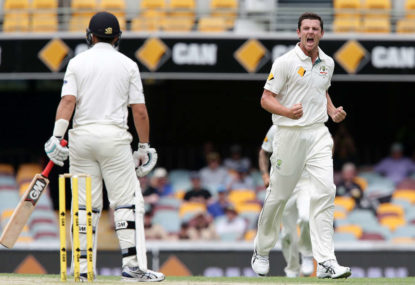Aussies leapfrog India in rankings despite neither team playing, Starc returns to form in IPL
Australia have reclaimed top spot in the ICC's Test rankings, replacing India. Despite not playing since winning 2-0 in New Zealand in March, Pat…

Suresh Raina’s slash over point might have ended this international summer of cricket on a bleak note for Australian supporters, but in truth there’s been little to cheer about for fans of the game.
True, the Aussies enjoyed an undefeated summer up until the last ODI against India, but from a purist’s point of view, there were few passages of truly gripping cricket.
The reason?
Poor pitches; surfaces that were seemingly prepared to make batting as simple as possible.
For the Twenty20 series against India, such pitches can be excused. The format’s requirement for batsmen to score at eight to ten runs an over from the first ball tends to create wicket-taking opportunities regardless of the conditions.
For ODIs, the flat decks are not as forgivable. For Test matches, they are even less so.
The pitches prepared for the one-dayers offered no seam movement and little swing, and led to the highest-scoring five-match ODI series in the history of cricket.
Similarly, the surfaces for the Test series against New Zealand and the West Indies were tame enough to turn Adam Voges into the second-greatest batsman in Test history, if batting averages are anything to go by.
The problem isn’t that there were plenty of runs scored in the summer. It is that they were scored in such a monotonous fashion that the gripes often aired by Test cricket’s critics – it’s boring, it’s too slow, it goes for five damn days and nothing ever bloody happens – almost began to ring true.
The Tests against New Zealand generally saw a period of slightly probing new-ball bowling, which quickly gave way to 70 overs of dominant batting.
The WACA pitch in particular was so benign that, barring a calamitous batting performance, a draw seemed the only possible result after a just couple of overs.
The ODIs were much the same; each game inevitably saw batsmen go hard for the first ten or so overs before meandering through the middle part of the innings at five or six an over without anything even remotely resembling a risk, and then letting loose in the closing stages.
Sure, it led to a few memorable last overs, but the bulk of the games were dull affairs, with batsmen and bowlers alike going through the motions, unable to spark the match into something unexpected.
It’s not that the cricket was boring, it’s that it was monotonous and repetitious. It was like an album comprised the same ten songs, all played in a slightly different key.
Actually, stuff it.
It was boring. Boring as it was predictable.
The one exception was the day-night Test in Adelaide. A game which hung in the balance for its entirety. A game which was unpredictable. A game which, until Peter Siddle squeezed away the winning runs, no-one really knew who was going to win.
Was it a coincidence that this sole exciting Test happened to be played on the one pitch that offered some assistance to the bowlers?
I think not.
Now, don’t mistake this for a call to turn every Australian pitch into a grassy minefield. Criticism of surfaces that offer far too much for the bowlers – the most recent example being the Nagpur pitch prepared for South Africa’s tour of India – is justified.
But pitches like Nagpur should never be considered that much worse than what was prepared for the Perth Test this summer. After all, why should batsman-friendly surfaces be deemed acceptable while bowler-friendly ones are derided?
What is needed is a balance between bat and ball; pitches that make batsmen work hard to maintain their wickets in the face of quality bowling, but ones that require bowlers to earn their scalps. The Adelaide Oval pitch was one such example.
It is a fine balance, but one which should be strived for.
With Test cricket struggling to retain audiences and ODIs losing relevance to the behemoth that is Twenty20, creating bowler-friendly pitches should become increasingly important, for it is more often than not the bowlers that determine just how gripping – and hence how entertaining for viewers – cricket is.
On flat pitches, bowlers are little more than metronomes, able to determine the tempo of a match, but incapable of changing its tune.
On evenly-balanced decks however, bowlers can find their voice, and add the colour and emotion a match requires.
And cricket is all the better for it.
High-scoring innings are far fewer, and hence appreciated so much more. Centuries and even half-centuries are that much more valuable when runs are earned in spite of relentless bowling. Spectators are tied to the very edge of their seats, not knowing what direction the game will veer towards.
Cricket becomes unpredictable. It loses its monotony. It becomes exciting.
We may not have been treated to much cricket of that ilk this summer, but let us hope next season can deliver.